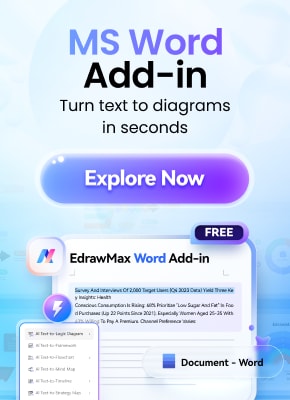
In the world of banks, understanding how data connects is a crucial aspect. Entity-Relationship (ER) diagrams serve as visual roadmaps, showing the relationships between entities in a bank’s database, from customer transactions to account management.
This article explains how ER diagrams simplify bank management, offering a clear view of complex data structures. It includes ER diagram templates from EdrawMax and guides you on creating your own using Wondershare EdrawMax, helping you get started quickly.
In this article
10 ERD Templates for Bank Management Systems
Here are 10 ER diagram templates for bank management systems to guide your creation process. These editable templates can also be customized for other industries. Explore them to inspire your designs using Wondershare EdrawMax.
Example 1Bank Accounting System
First, this simple ER diagram shows a customer’s relationship with the bank’s accounting system. It covers the basic information like name, address, and customer ID. It even has provisions for credit cards. You can edit this accordingly based on what your banking system’s database covers.
Such diagrams are great for the customer service or relationship departments, so they’re guided by relevant customer information.
Example 2Larger Banking System
This second example is a comprehensive ER diagram for larger banking systems. This can help manage or guide employees in accessing data from different branches. So, if your bank has multiple branches, this ER diagram has you covered.
It shows the customer’s relationship with their designated branch and the bank system as a whole. It even has dedicated nodes for loans, account numbers, etc.
Example 3Colorful Banking System
This example is similar to the previous one, except it’s more colorful. Since it has provisions for Roll numbers, you can make a specific ER diagram for each set of customers. You can even track who offered what and which employee maintains the particular client. It’s complete with nodes for customer information, account details, and bank addresses.
Example 4Online Bank System
This ER diagram presents an online bank system. Seemingly like a flowchart, it showcases the flow of how customers get access to the bank’s services. It covers the initial customer input and shows what they can access from the login portal.
It’s great for software engineers to detect problems where they come around easily.
Example 5Moblie Bank Application
This ER diagram is for a mobile banking app. You can designate which datasets the application accesses when the “seeker” inputs into the app. This is also great for software engineers, especially since it uses a simple design. Edit this template and its information if your app needs other information.
Example 6Banking Transaction
Great for business information systems, this ER diagram showcases the transaction process. You can use this to start a bank business or branch. It starts from the deposit or loan to the withdrawal and other relevant information, such as which branch the transaction will come from. It’s a good starting point for creating more complex bank systems.
Example 7Concise Banking Transaction
This black-and-white design cuts through the noise, focusing on essentials. It outlines the bank code, name, address, branches, and vital connections like bank-branch relationships. Dive easily into loan processes, transactions, and customer details – perfect for a quick, comprehensive overview.
Example 8Code-based Banking Data Process
For the tech-savvy, this example speaks in the language of coding. Manager details, personal information, and the crucial codes for transactions and accounts take the spotlight. It is ideal for those who love diving into the nitty-gritty of the banking data processing realm.
Example 9User-friendly Table Design
For a deeper dive, it introduces complexity with a user-friendly table design. Uncover intricate connections such as customer passcode access and more, all expressed in the language of computers. This template is your go-to for a detailed exploration of diverse bank information.
Example 10Entire Banking Process
Closing the list, It offers a straightforward yet powerful snapshot of the bank system. Unveil payment dates, account numbers, interest rates, and crucial customer details like Social Security numbers. Perfect for illustrating the entire banking process with clarity.
How To Make an ER Diagram With EdrawMax
Now that you have some ER diagram inspiration, let’s dive into creating one. To draw ER diagrams for bank management systems, you’ll need a powerful tool like Wondershare EdrawMax, a simple ER diagram maker. Known for its simplicity, EdrawMax offers features tailored to the banking industry’s needs.
Follow the steps below to create your ER diagram with ease.
Step 1
- Download EdrawMax on your device or try it online.
- Log in with a Wondershare, Google, Facebook, or Twitter account.
Step 2
- Click +New,
- then + Blank Drawing.

Step 3
- Add shapes from the left panel to your canvas.
- This will serve as your diagram’s main nodes.

Step 4
- Add relationships by dragging the small dots on the side of each shape to your designated spot.

Step 5
- Add text to your shapes by double-clicking them and typing away.
- You can also customize the shape/line/text colors using the appearing customization bar.
- Repeat the steps as needed until you finish your diagram.

Introducing EdrawMax: A Free ER Diagram Maker
Wondershare EdrawMax is a pioneering solution in diagramming, offering unparalleled versatility and simplicity for users across diverse industries. With a special focus on the intricacies of bank management systems, EdrawMax emerges as a comprehensive toolkit for creating detailed and insightful ER (Entity-Relationship) diagrams tailored to the specific needs of financial institutions.

Ever felt tangled up while creating diagrams for your bank systems? Enter EdrawMax – a game-changer in the world of diagramming, here to make your life easier. Especially for those ER (Entity-Relationship) diagrams in banking, EdrawMax has got your back.
- AI Tools: EdrawMax incorporates AI tools such as OCR (Optical Character Recognition), Copywriting, Diagram/Table Analysis, AI Chat, and AI Drawing. These tools enhance the efficiency of diagram creation by automating tasks like data extraction, content generation, analysis, collaboration, and image generation.
- User-friendly Interface: EdrawMax offers an intuitive and easy-to-learn interface, allowing users to focus on content creation without grappling with complex software navigation.
- Template Library: The extensive Templates Community, with over 22,000 templates, empowers users to find the right template for their bank management ER diagrams. This feature facilitates quick and efficient project initiation.
- Diagram Variety: EdrawMax supports over 210 diagram types, ensuring versatility beyond ER diagrams. Users can seamlessly create flowcharts, organizational charts, network diagrams, and more.
- Huge Symbols Library: Tailored for professionals, EdrawMax provides a comprehensive symbols library with industry-standard symbols, even those relevant to financial systems. This feature accurately represents components and relationships in bank management ER diagrams.
Conclusion
Overall, you’ve seen how ER diagrams for bank management systems help clarify complex data structures. It enhances operational efficiency and aids strategic decision-making. It also offers help for software engineers and other banking employees. These tools can help the whole organization understand the bank management system more.
EdrawMax emerges as an optimal solution for ER diagrams and a comprehensive toolkit for various diagramming requirements. It is a reliable companion, simplifying intricate processes and facilitating a profound understanding of bank management systems. Opt for EdrawMax, where formality meets simplicity, ensuring a seamless journey into the nuanced world of financial structures.














